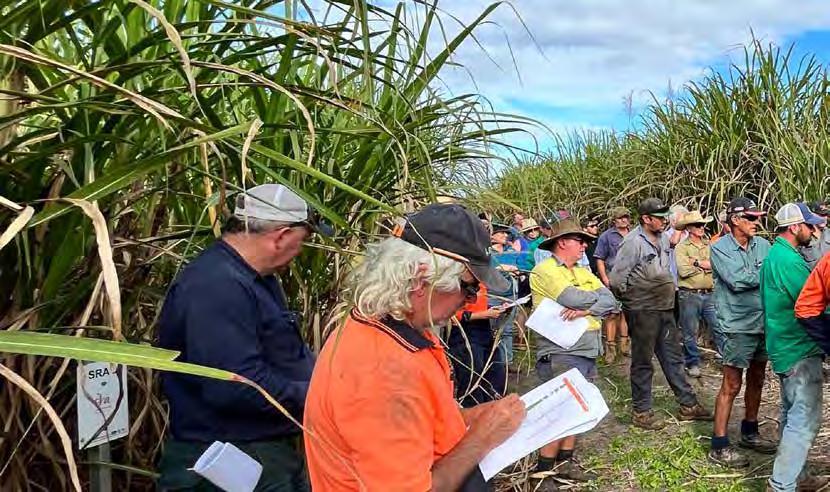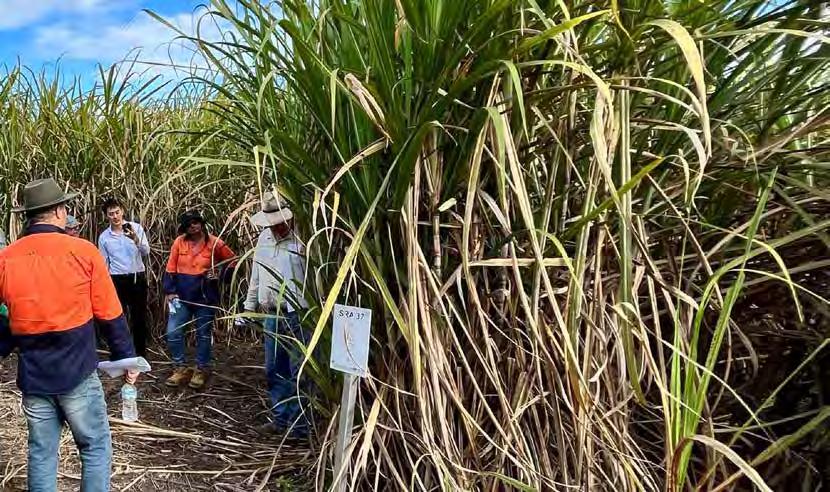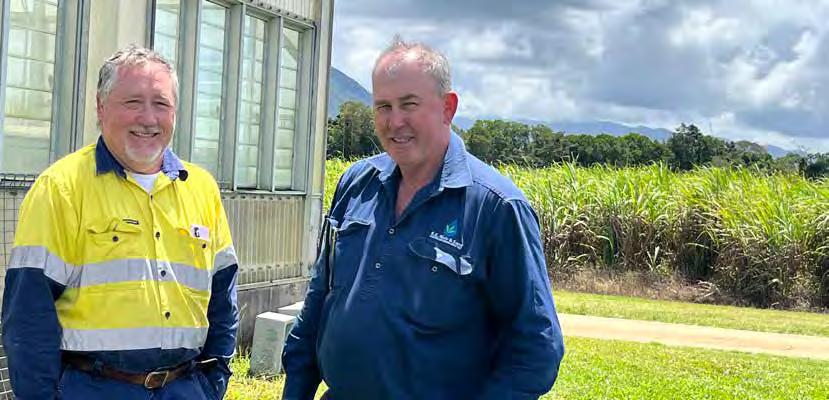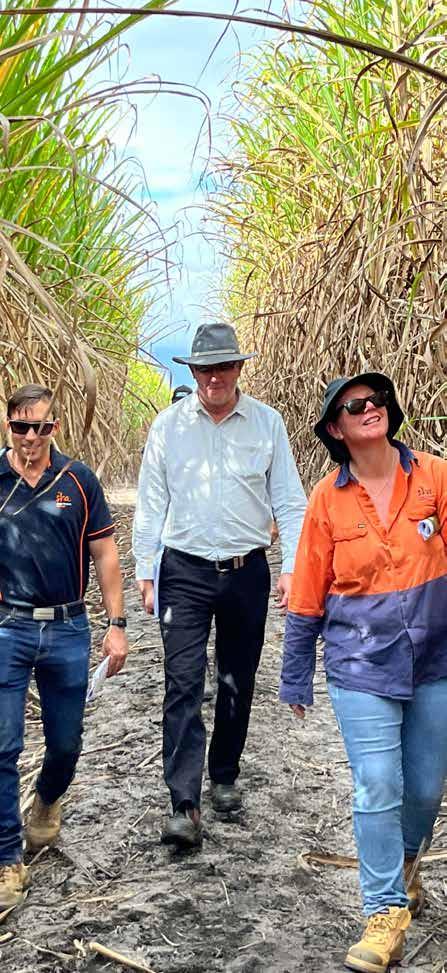
7 minute read
VARIETY SELECTION AND PLANNING: IT’S ALL ABOUT FINE-TUNING THE DATA
Supplied by Sugar Research Australia
Each year Sugar Research Australia (SRA) plants 100,000 seedlings looking for new sugarcane varieties with the single objective of maximising whole-of-industry profitability for sugar production.
Dr Felicity Atkin is a plant breeder and SRA’s Variety Development Manager, North based at the Meringa station. She is the first to acknowledge that no one variety is going to cover every situation on all farms.
“Each SRA variety released by the Regional Variety Committee (RVC) is assessed on its performance, disease resistance and industry needs; but they all have additional individual qualities,” Felicity said. “And there are a lot of good qualities to consider and varieties to choose from.”
To support growers selecting new varieties to plant and trial on their farm, each year SRA produces a variety guide for each of the six cane growing regions in Queensland and NSW. The guides include the best available data of regional variety performance and disease ratings.
“We like to release the variety guides early in the year, so that we can then work with growers, and industry groups to encourage the adoption of our new varieties,” Felicity said.
One such group is the Tully Variety Management Group (TVMG). SRA has been a member since its establishment in 2012 by Tully Sugar Limited, along with Tully Cane Productivity Services Ltd (TCPSL), CANEGROWERS Tully and individual growers.
The group operates in the two-to-three-year timeframe between approval of an SRA variety by the northern RVC and commercial planting.
“The TVMG do a fantastic job in continuing the work we have begun by ‘filling in the gaps’ for the grower, on a localised, district level,” Felicity said.
“The TVMG identify where they feel that additional work can be done to improve productivity and target areas to put the new varieties and to refine variety recommendations.
“Through this work we can reduce the potential failures arising from planting certain varieties in the wrong spot. This then leads to getting the best productivity results from those varieties and improving overall productivity and profitability for the Tully region.”
In the past seven years, 14 new varieties have been released in the north. Tully Sugar’s Cane Productivity and Development Manager Greg Shannon says that is good news for growers in relation to disease resistance, but at the same time can be confusing when it comes to planning varieties for next season.

“SRA’s variety guides tell you 90% of what you need to know about new varieties,” Greg said.
“What we’re doing on Tully Sugar’s farms and other sites (10 in total) is working to fast track the varieties that we believe will work, in each of the eight sub-districts in Tully.”
Greg explains that small plots with only a couple of rows of each new variety are planted out, in four areas around the Tully region.
“We gather a lot of good data from those plots, for growers and for the mill. We’re continually analysing what we’re seeing and share the data with the industry on a weekly basis,” he said.
“It’s that data that enables us to fine-tune new variety recommendations released by SRA, relevant to our region. That in turn helps growers make better informed decisions on the varieties they’re going to plant.
“We’re doing that 10% final assessment so that our growers don’t have to,” Greg said.
CANEGROWERS Tully Chair, Bryce MacDonald said the organisation has always participated in the TVMG and ‘it’s important that we do’.
“With the Tully milling area currently capped at 35,500 hectares we must plant better varieties that produce more tonnes of sugar per hectare; there’s no restriction on that.
“If you want the best results of anything, then you must rely on science. And disseminate the information properly,” Bryce said.
“The work that Greg Shannon at Tully Sugar and Peter Sutherland at TCPSL are doing and the data they are collecting in the Tully district are helping us achieve that.

“It’s important that the right varieties are planted in the right area, considering our micro-climates,” Bryce said.
“For example, the Murray region is the biggest cane growing district in Tully, but within that area there is a distinct dry Murray and wet Murray.
"So even in those areas some varieties are going to be better than others, and growers need to have the data before they decide what to plant.”
Peter Sutherland is District Manager of TCPSL and says that a lot of growers ‘still shop with their eyes’ but that data needs to inform variety choices.
“Our work and contract with SRA is to propagate and distribute new varieties. In parallel to that we conduct our own trials and compare that data with the TVMG members. Crop presentation for harvest is important but it’s not all about how it looks,” Peter said.
“Often if the cane is tall in the plot, a grower will go for it. So, it’s important we get actual mill data as quickly as we can, particularly at the critical period of second and third ratoon. This hard evidence is what most growers are looking for in the Tully district.”
Peter admits to liking statistics.
“I get to analyse our data once a year,” he said. “Greg analyses his plots every week but we’re continually collaborating and looking at everything we do from a different perspective.
“We’re all looking for the best performers, and how to manage them. A variety harvested in November may be average but cut it earlier in the year and it’s exceptional. A cane may fall over, so we plant another early cane beside it. Variety selection and planning is about farms within farms,” Peter continues.
“The TVMG doesn’t tell growers what to do, they know their land better than we do. We give them the options and the skill set and make sure we have the varieties when they want them,” Peter said.

Each year the TVMG, facilitated by Greg Shannon holds an End of Early Season Review. This includes a farm walk to inspect and discuss the planted varieties on the mill’s farm south of Tully to encourage adoption of the new varieties. Felicity Atkin and Andrew Rigby, SRA Variety Officer, travelled from the Meringa station to contribute to the event in August.
“We like to attend grower and miller meetings where and when we can,” Felicity said.
“This event had everyone across the whole value chain there – including the marketing team from Tully Sugar - which was great. And while this was Tully Sugar’s event, as the breeder of the varieties, there were questions asked on the day that I could answer, versus Greg’s local knowledge of the varieties. It was encouraging to hear the commentary that Greg gave and his experience with the varieties that complement the experience from our trials,” she said.
“It was also nice to see some of our recently released varieties in the field and hear what growers thought of them. SRA37 was only approved and released last year. It looked impressive and there were several growers casually talking about how well it had germinated on their farms, the same with SRA9; that was good to hear.”








